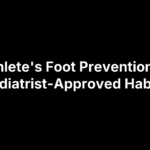Sore arches, cracked heels, stubborn odor, or itchy skin between the toes—small foot issues can snowball into infections, nail problems, and pain that slows you down. Because your feet spend hours in socks and shoes, they live in a warm, moist environment where bacteria and fungi thrive. The good news: most problems are preventable with a few consistent habits.
This podiatrist-approved routine turns foot care into a simple daily practice—no spa day required. In just a few minutes, you’ll clean properly, dry thoroughly, moisturize the right way, manage sweat, and make smart choices with socks and shoes. The steps are evidence-based, safe for most people, and easy to tailor if you’re managing diabetes, training hard, pregnant, or caring for aging feet.
Below, you’ll find a clear, step-by-step guide for your daily routine, weekly add-ons, shoe and sock hygiene, at-home tools, and red flags that mean it’s time to see a specialist. Ready to build healthier, softer, problem-free feet—starting today? Let’s begin with Step 1.
Step 1. Start with a quick daily wash using warm water and mild soap
As part of your daily foot care routine, wash your feet quickly in warm (not hot) water with a mild soap. Lather tops, soles, heels, and between toes for 20–30 seconds; skip long soaks that strip oils and invite fungus. Rinse well to remove residue that can dry or irritate skin. Be gentle—use hands or a soft cloth, not abrasive tools. Then move to the next step: drying completely.
Step 2. Dry thoroughly, especially between your toes
As soon as you finish washing, dry thoroughly. Pat with a clean towel and get between every toe. Leaving moisture, especially in toe spaces, creates the warm, dark environment fungi love and raises the risk of athlete’s foot. For extra moisture control, dust a non‑medicated foot powder once skin is dry. In your daily foot care routine, this step prevents maceration, controls odor, and preps skin for moisturizing.
Step 3. Moisturize correctly (heels and soles, not between toes)
After drying, as part of your daily foot care routine, moisturize the heels, soles, and tops—never between the toes, where trapped moisture can fuel fungus and infection. Choose a rich cream for daily use; for thick, rough heels, look for urea 10–20% or lactic acid 5–12% to soften and smooth. Use a fast‑absorbing lotion in the morning; at night, seal with a thin layer of petroleum jelly and cotton socks. Massage to boost absorption.
- Amount: Apply a pea‑to‑nickel amount per foot; wipe excess before socking up.
Step 4. Control sweat and odor throughout the day
Sweat trapped in shoes creates a warm, dark, moist environment where odor‑causing bacteria and fungi thrive. As part of your daily foot care routine, control moisture to protect skin and prevent athlete’s foot while keeping odor in check all day.
- Powder after drying: Dust feet with nonmedicated or antifungal foot powder in the morning and post‑activity.
- Swap socks: Change socks at least daily; carry a spare for a midday change if sweaty.
- Breathe and rotate: Wear breathable shoes and rotate pairs so each dries for 24 hours.
- Quick refresh: After workouts, wash, dry fully, then re‑powder before putting on clean socks.
Step 5. Put on clean, breathable socks that wick moisture
As part of your daily foot care routine, put on clean, breathable socks that wick moisture. Choose merino wool or synthetic blends instead of 100% cotton, which holds sweat. Go for seamless toes and a snug—not tight—fit. Change socks at least daily and after exercise, wash in hot water, dry fully, and skip damp or worn‑out pairs.
Step 6. Choose supportive, well-fitting shoes and rotate pairs
Shoes can make or break your daily foot care routine. Supportive, well-fitting, protective footwear helps prevent blisters, calluses, ingrown nails, and overuse pain. The CDC recommends well-fitting, protective footwear, and podiatrists advise rotating pairs so each dries out for at least 24 hours—critical for keeping moisture and microbes in check.
- Prioritize fit: No tight spots or rubbing; ample toe room; heel feels secure without slipping.
- Choose support: Sturdy heel counter and cushioned, supportive midsole for your activity.
- Let feet breathe: Opt for breathable materials to reduce sweat buildup.
- Match the task: Use activity-specific shoes (work, running, court) to reduce strain.
- Retire worn pairs: Replace shoes with flattened cushioning or uneven tread wear.
Step 7. Freshen and disinfect your shoes regularly
Shoes can harbor odor‑causing bacteria and fungi; keeping them clean reduces infection risk and keeps your daily foot care routine working. Make this a quick habit after wear or workouts so pairs stay dry, fresh, and ready for the next day.
- Air out: Remove insoles when possible and let shoes dry 24 hours.
- Disinfect/deodorize: Use a shoe spray or antifungal powder inside, then tap out excess.
- Clean smart: Follow manufacturer directions for cleaning; always dry completely before rewearing.
- Store dry: Keep shoes in a ventilated area, not packed in damp bags.
Step 8. Inspect your feet daily for cuts, blisters, swelling, or nail changes
Make a quick visual check the final step of your daily foot care routine. Under good light, use a hand mirror (or a phone photo) to see soles, heels, and between toes. Look for cuts, hot spots, blisters, redness, swelling, cracks, peeling skin, and nail changes like thickening, discoloration, or lifting—early clues of fungus or infection.
- Clean and protect minor issues: Wash with mild soap, dry completely, and cover with a sterile bandage. Reduce friction with different shoes or padding.
- Know red flags: Spreading redness/warmth, drainage, foul odor, sudden swelling, numbness/tingling, or dark discoloration—contact a podiatrist.
- If you have diabetes: Inspect daily, never go barefoot, and seek prompt care for any sore or skin break.
Step 9. Exfoliate and smooth rough skin 2–3 times per week
To keep heels soft without over-thinning skin, add gentle exfoliation to your daily foot care routine two or three times weekly. After bathing—when skin is soft—briefly smooth callused spots. This prevents cracks and reduces pressure points that can turn into painful corns or blisters.
- Use gentle tools: Pumice stone or foot file; short, light strokes.
- Target areas: Heels and balls of feet; skip healthy skin.
- No razors or harsh acids: Avoid over‑the‑counter “corn/callus removers.”
- Finish strong: Rinse, dry fully, then moisturize heels and soles (not between toes).
- If you have diabetes: Speak with a podiatrist before any home debridement.
Step 10. Trim toenails weekly and care for cuticles safely
Plan a quick weekly trim as part of your daily foot care routine. It prevents ingrowns, pressure, and infection. Trim after bathing when nails are softer. Use clean clippers and good light, finish with a file, and protect the cuticles—they’re your barrier against germs.
- Cut straight across: lightly smooth corners with a file.
- Don’t go too short: leave a thin white edge.
- Skip digging/rounding: never dig into sidewalls or round deeply; avoid tearing.
- Protect cuticles: don’t cut them; soften, gently push back, moisturize. Diabetes or thick, painful nails? See a podiatrist.
Step 11. Protect your feet at home and in public (showers, pools, and salons)
Your skin is your first defense. Communal wet areas and poorly sanitized tools can spread athlete’s foot and nail fungus, so build protection into your daily foot care routine. Wear protective footwear, keep feet clean and dry, and be selective with salons—proper hygiene there matters as much as at home.
- Public showers/pools: Wear shower shoes, wash after, and dry thoroughly (between toes).
- Salons: Choose clean, state‑licensed salons that sterilize instruments after each use; skip fish pedicures—some states ban them and they can spread infection.
- Travel/outdoors: Don’t go barefoot where soil may be contaminated; this helps prevent hookworm in endemic areas.
Step 12. Customize your routine for diabetes, athletes, pregnancy, and seniors
Different life stages and health conditions change what your feet need. Keep the core daily foot care routine, then layer on these targeted tweaks to prevent complications, stay comfortable, and catch problems early.
- Diabetes: Inspect daily, never go barefoot, wash and dry carefully (especially between toes), moisturize heels/soles only, and wear well‑fitting, protective shoes. Report any sore, redness, or drainage promptly.
- Athletes: Post‑workout wash, dry, and re‑powder; change into dry, wicking socks; rotate sport‑specific shoes; treat hot spots early; consider orthotics for support.
- Pregnancy: Elevate to reduce swelling, do gentle ankle pumps, wear supportive low‑heel shoes with a wide toe box, and recheck fit as feet change.
- Seniors: Prioritize daily inspection, gentle cleansing, regular moisturizing of heels/soles, stable supportive footwear, and safe nail care; seek help if reaching feet is difficult.
Step 13. Build a podiatrist-approved foot care kit
Keep a small, grab-and-go kit so your daily foot care routine stays quick and consistent at home, the gym, or travel. Include safe basics that cover cleaning, drying, moisturizing, friction control, and first aid.
- Mild soap and soft towel.
- Foot powder (nonmedicated) for dryness.
- Heel/sole cream (urea or lactic).
- Pumice stone or foot file.
- Clean clippers + file + mirror.
- Bandages + shoe disinfectant/deodorizer spray.
Step 14. Know when to see a podiatrist
Even with a consistent daily foot care routine, some problems need expert care to prevent complications. Schedule a podiatry visit promptly if you notice the warning signs below—treat concerns as urgent if you have diabetes, neuropathy, or poor circulation. Don’t wait for symptoms to “work themselves out.”
- Persistent pain or swelling
- Spreading redness, warmth, drainage, or foul odor (possible infection)
- Cuts, blisters, or ulcers that aren’t healing
- New numbness, tingling, or burning
- Ingrown toenails or thick, crumbly, discolored nails
- Recurrent calluses, corns, or blisters despite good footwear
- Itchy, peeling, or cracked skin between toes (possible athlete’s foot)
- Sudden injury, deformity, or inability to bear weight
Early assessment keeps you active and helps prevent infections and long recovery times.
Next steps
You now have a simple, repeatable plan: wash, dry, moisturize; wear wicking socks; choose and rotate supportive shoes; freshen footwear; inspect daily; and add weekly trimming and gentle exfoliation. These small, consistent habits prevent infections, calluses, ingrown nails, and odor—while keeping your skin soft, your steps comfortable, and your day on track.
Make it stick by keeping your foot care kit where you’ll use it, setting a weekly reminder for nails/exfoliation, and swapping worn socks and shoes on schedule. If you spot red flags, have diabetes, or your pain keeps returning, get tailored care from a specialist. For convenient, same‑day appointments and comprehensive podiatry across Central Virginia, schedule with the team at the Achilles Foot and Ankle Center: Achilles Foot and Ankle Center. Your feet will thank you tomorrow—and years from now.






